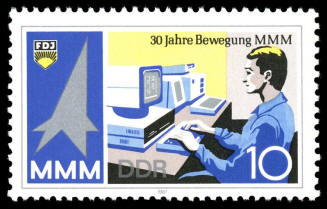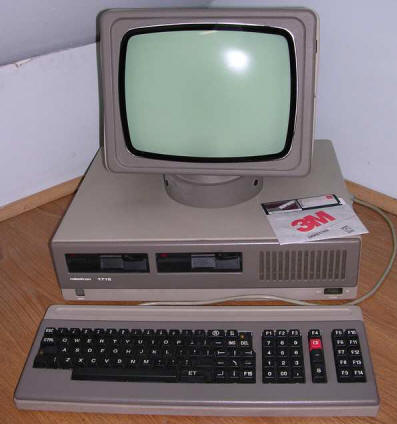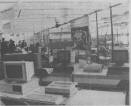Robotron PC 1715
A CP/M machine from East Germany, Robotron PC 1715 was
used in many applications: As office computer, educational, programing,
there were even versions with interface to program pacemakers. Some
network interfaces also were built. Because
it was made with elementary TTL logic it was quite reliable and
replacement parts were easier to find. Unfortunately repairing was
terrible, as there are dozens of these TTL circuits inside.
Robotron 1715 used only text mode. There were no graphic or sound
capabilities, yet there were some prototypes of graphic mode expansion
cards. Most CP/M software uses terminal configurations unusable with
1715. 1715 has 64K of memory, expandable to 256K with special expansion
card. 256K units, PC 1715W (earlier schematics show name PC1715M, but
there's some confusion with another model, this time with faster CPU
clock), are rare and
have additional floppy drive capabilities - you could boot only from
first FDD, secondary had higher density and was able to read, write and
format non-standard disks. They had also 4MHz clock.
Eariler PC1715 had 360K/400K disk drives. Next versions, where mostly 256K
were manufactured, had one 800K drive (about 650K usable) and one 360K
drive. Later produced 64K models had only higher density 800K (Quad
Density) drives,
these ones are the most popular units.
Here you can find a few photos from manufacturing plant!
I tracked my unit to Kovocas - now defunct (in fact in 2010) Czech factory making seltzer bottles. You can still see their web page in the Internet Archive. Software disk comes from JZD Agrotechnika Slusovice.
There are many models known, built to suit customers
needs. Some contain modified character ROM to display cyrilic, German,
Polish or semigraphic characters. It was impossible to just buy a
Robotron privately, as it was very
expensive, so purchasing a computer was only possible to authorities
- and many of them had subsidized part of costs. On the other hand
buying a computer (usually by national factory or cooperative) in times
of applied socialism returned in first months, as optimized plans
computed with database software gave bigger savings.
Earlier units had white case and have part of keys made of white
plastic.
Ah, and the keyboard. There were 3 keyboard types:
- Type 1 - with these plastic semi-transparend buttons on the right side
of keyboard
- Type 2 - with normal square buttons, but with round "heads" - something like in
ZX Spectrum Plus.
- Type 3 - with round-square buttons, every button had a small hollow to
easier finger typing.
The keyboard is in fact a serial terminal transmitting device! It has
its own micro-controlling circuitry, Z80B, EPROM etc.
If you have a K7637 (the one with lock plug on the right) keyboard, DON'T CONNECT IT TO 1715! You'll DESTROY all serial logic, rendering computer unusable!
| One more curiosity: On the right you can see a
postage stamp scan (from
Wiki Commons) from 1987, issued in 30th anniversary of the "Messe
der Meister von Morgen" - a young researchers competition and
exhibition in German Democratic Republic. The young student is using Robotron 1715 computer, where the computer in the backrgound is older Robotron A5120 (you can see it on another stamp), slower, with less memory, but compatible machine used widely to nearly everything requiring the computer - I saw one controlling a socks weaving machine manufactured in 1983. As I know today (2011) it still works well without any repairs. |
 |
Here's my attempt to describe mainboard.
| Contents: | Starting | Recording media | Serial boot | Pinouts | Links |
Starting:
It has VERY simplified ROM software. There's only one
thing in there:
1. BOOT OPERATING SYSTEM FROM DRIVE 1.
2. IF NO DISK, TRY DRIVE 2
3. TRY SIO (undocumented!)
3. IF STILL NOT BOOTED (no disk, no SIO wakeup), GO TO 1.
It means that when you turn it on, it should try to boot from floppy drive 1, then drive 2, and again drive 1, then drive 2... until you supply a system disk. Light should be lit on drive 1 then drive 2, then again drive 1 etc. The boot ROM won't display anything on screen. To briefly test CRT, try to turn it on with signal cable disconnected from computer. It should become green.
After floppy is placed in drive and drive is tried, Robotron should move drive's head back and forth. If the disk is good, it'll boot with one more head step. If it's totally different thing, it'll ignore the disk and go to another drive. If the disk is unreadable, it'll hang with black screen. If you are sure that disk is 100% OK, and Robotron only tries it and ignores it, it means that the problem is in drive or controller.
One more thing, which is quite important. If you disassemble your machine and see that there are 2 character EPROMs inserted in two sockets near display controller, not one EPROM and empty socket (and then display controller), it means that your Robotron has 2 character sets. It's quite frequent in non-German units. You can switch between these fonts using SI/SO key. After you press the key, LED will toggle. Pressing any other key will actually switch character sets.
Here are some ROMs to download:
|
|
Robotron 1715 system ROM (EPROM near CPU) - no. s502 |
|
|
Keyboard ROM (typical keyboard, no regionalized keys) - no. s600 |
|
|
Character ROM - primary, German, - no. s619 |
|
|
Character ROM - secondary, Polish - no. s641 |
|
|
Character ROM - Russian Cyrilic - Probably primary and secondary. No idea which is which. - No.s605 and s643 |
|
|
Floppy controller ROMs - no. 068 and 069. These are installed as 1K ROMs, not EPROMs |
|
|
Floppy controller ROMs ready to be
burned in 2716 EPROMs for replacement.
WARNING! |
One more word of warning: There are 3 types of Floppy Controller
Schreib-ROM or 069 FDC ROM (known as Write-ROM) on the Internet.
- First has 1026 or 1027, but NOT 1024 bytes - it's bad, it was born as
data transferring error on FTP site. Unfortunately it got to my site,
now it's removed.
- Second has 0x04 as first non-zero byte. I don't know, but my 2 ROMs
don't have this and work. It is downloadable
here, if you want to experiment with it.
- ROMs in my website, they're confirmed they're OK (I had to replace
Schreib-ROM with EPROM), but I don't know will they work with Your
variant of Robotron. There were 2 variants of floppy controllers, I have
one known as Var. 02.
Recording media, using CPA operating system.
Robotron 1715 uses a non-standard 720K 5.25" floppy
discs called Quad Density. These disks spin at different speed and are
magnetized weaker than High-density 1.2MB. Only 1.2MB High-density
floppy drive can be used to write such disks in a PC.
It's easier to format a 360K disk to 800K than 1.2M to 800K. Why?
Magnetization strength.
More, after you make a boot disk, you should know that Robotron is very
picky about floppies used. Try with many, My unit booted from 6th or 7th
floppy made with PC. Yes, 360K.
To make system floppy, use a PC with high-density
(1.2MB) 5.25" floppy disk drive configured in BIOS as 1.2MB. DON'T USE
720K SETTING. Now you need pure DOS and 2 programs:
- CopyQM
- 22DSK and Robotron
Disk Definitions
You should also grab:
- A very limited boot disk image, contains some
first-need programs in Russian.
- Useful programs package. It's really minimal
pack of useful programs, only few more than in a boot disk.
- System Tools and Programming pack.
They contain RAMTEST, BASIC, Fortran and few other utilities. Notice
PMARC and PMEXT, it's an archiver. To extract PMA use PMEXT
A:ARCHIVE.PMA A: (extracts to A:, you can use B:). CRUN is some kind of
database. PCTEST is a Robotron testing tool.
- A few other CP/M programs:
- Spreadsheet
- Text processor (already
configured, try not to use TPINSTD, as it'll probably won't work)
- Games package (One, name
starting with N, I don't remember exactly, is not configured for
Robotron and it won't work)
- Database, version 1.0
- Database, version 3.3
- Database reporting
tool ??
If you dare, here's a full
dump of my boot (unfortunately it was unbootable) floppy from Czech
Republic. I HAVE NO IDEA WHAT ALL THESE PROGRAMS ARE FOR!
There's a tool for reading DOS 360K disks on a
Robotron, but I've never tried it!
Copy boot disk image to CopyQM directory. Now in pure DOS type:
copyqm b: /PLAYBACK=r1715.cqm
Now it should display a logo, ask for number of copies and write disk. Do not use CQMENU as it allows for non-direct controller access making the disk more unreliable.
This floppy should allow You to boot Robotron, format another floppies and make system floppies. This won't allow you to copy files, as it doesn't have a PIP utility, it should be copied to this disk (from my Useful Programs package) using PC and 22DSK utility.
To make another system floppy in Robotron booted from it (it's Russian written in Latin font):
A:init <----type init in prompt
(...)
Ukavi imq diskowoda: A
<----type drive to be formatted. You can use drive it was booted from,
just swap floppies.
I don't remember next question (like vozmovnye formaty ... wyberi format), use 3 for the biggest floppy size.
Now it should ask something like "w n i m a n i e ! Wse fajly budut udaleny" (Warning! all files will be gone) - if you choosen boot drive, swap disks now and press Y.
vdi! idet formatizaciq! (01) <--Wait, now formatting (track 01)
If you see:
o?bka!! ===> cboj dorovek!
it means track error. If it happens in the beginning, floppy may be unusable. Just remove it and reset computer, then insert bootdisk again. Most 1.2MB disks won't be formatted well in Robotron, giving this error in the beginning or in 30-55th track.
This shows end of formatting. Type any key to return to
drive menu, Ctrl-C to exit:
konec formatizacii (end of
formatting)
Now let's install system: Type:
A:sgen
Then choose 2 (zagruzka aktiwnoj sistemy).
Now boot system is loaded to be transferred to floppy. Now choose 7 (zapisx SCP na disk - write SCP to disk) and choose newly formatted floppy drive, or swap it if using boot drive. Boot block is prepared. But system must be on a disk. Choose 5 (zapisx SCP w wide fajla - write SCP to file), type name of the command file (A:scp-dos.com or B:scp-dos.com - if new disk is in B:), the disk should become fully bootable.
If you made error, and you must delete file, use ERA
filename.ext command.
Display disk's contents using DIR.
TYPE filename.ext displays file contents.
Switch between floppies using A: or B: commands. Usually C: and D: are
external 2 drives, if connected (but it can be changed with INSTSCP
utility).
This OS is quite limited, as it doesn't have a PIP. PIP
is the shell allowing file manipulations, for example copying:
PIP B:FORMAT.com=A:INIT.COM
Copies A:init.com to B:format.com. In SC/P there are NO DIRECTORIES. You
list the contents of current disk with DIR command. Change by A: or B:
command.
Remember: PIP destination=source. NOT like in MS-DOS. It was made
long time ago by programmers who were more familiar with such notation.
We must get PIP to the disk using our MS-DOS computer
with 5.25" disk drive. Extract 22dsk, replace the definitions file with
one suupplied in this page. Now you're ready to list, import and export
files from Robotron disks. Just start CMENU in 22dsk directory, choose
disk type, choose drive and you can go. Remember to type properly and,
as you export from Robotron floppies, always export to existing
directory. It won't create a new one but one big, unusable file.
Using 22DSK you can copy PIP and other programs/utilities available in
the Internet (as CP/M software, not DSK disk image files) to Robotron
floppies and back - read data from Robotron floppies to PC's hard disk.
The only thing you should remember is that during importing files from
Robotron disks 22DSK renames COM files to CPM. Just use "ren *.cpm *.com"
in your disk dump's directory to get original names.
With 22DSK you can copy program packages from this site do disks,
formatted in Robotron 1715. They should be made bootable by "zapisx SCP
na disk" command, but they don't have to conatin SCP-DOS.COM file, as
it's already in these packages.
During importing files from the Internet notice that:
- Robotron has Z80 processor, not Intel 8086.
- Robotron has non-standard display circuitry, so most western programs,
even these with terminal configuration, won't work properly displaying
garbage (or only cursor) on screen.
- PMA files should be extracted in Robotron to a disk using PMEXT.
Serial port booting:
It is theoretically possible to override defective FDD controller and boot Robotron from serial port. The original page describing the process is gone, but some cites survived here, so here's a brief explaination in English:
1. Connect serial to PC. Parameters: 9600, 8-bit, 1 stop bit,
Parity: Odd.
2. Turn it on or Reset. It'll query all drives and then serial
port for booting signature.
3. Start sending "0x11 0x11" to serial port until you see "0x12 0x12"
output. Then stop, as it's ready for taking program.
4. Send 0x0A 0x(start address low) 0x (start address high) of files.
Probably also length of a file in the same format.
as I understand, there are two files you have to stuff in there: BIOS
with CRT initialization and operating system.
After it there should be 0x0A, then start location in the discussed
format.
As there's nothing to boot from, you should just check if
it responds 0x12 0x12 to serial port (use only 3 wires connected
nullmodem - GND (Robotron A1), Rx (Robotron B4) and Tx (Robotron
A2)). If it responds and still doesn't boot, it means that FDC/memory
(chips closest to keyboard connector are the lowest) is faulty or boot
floppy is bad.
Exact pin configuration:
V.24
Rx (to pin 3 of DB9)
|
|-----------------------------|
| * * * * *
* * |
| * * * * *
* * |
|-----------------------------|
^ ^
GND |
| Tx (to pin 2 of DB9)
(to pin 5 of DB9)
(view from back of robotron)
Pinouts:
Connector numbers - they are as in Service Manual. Terrible, but if you see it for long time, you'll get used to it.
What's going on with these "Pin x" numbers?
These pinouts are, or are designed to be, configurable by internal DIP
switches. Not all pinouts go that way, some are just designed to it, but
DIP switches have never been installed on mainboard and they're
hardware-set default to some config. Many Robotron docs use "pin"
notation instead of normal marking.
Keyboard connector:
|
|
| 1A - Clock 2B - +5V 3A - GND 4B - Data 5A - Shield |
Printer connector:
|
|
| 1A - Pin 102 - Ground 2B - Pin 103 - TxD 3A - Pin 106 - CtS 4B - n.c 5A - Shield |
IFSS connector, if expansion card installed:
|
|
| 1A - SD- 2B - SD+ 3A - ED- 4B - ED+ 5A - Shield |
Serial V.24 connector has 13 pins, but naming goes the same way:
|
|
| 1A - Pin 102 - Ground 2B - Pin 101 - Protective ground 3A - Pin 103 - TxD 4B - Pin 104 - RxD 5A - Pin 105 - RtS 6B - Pin 106 - CtS 7A - Pin 107 - DSR 8B - Pin 108 - DTR 9A - Pin 109 - DCD 10B - Pin 111 - Signal rate selector 11A - Pin 113 - External transmit clock 12B - Pin 114 - ?Transmitted bit buffer? 13A - Pin 115 - Receiving clock |
Video output:
|
|
| 1A - Intensity 2B - GND 3A - B_SYNC 4B - Shield 5A - Video signal. |
Monitor power supply:
|
|
1 - GND |
External floppy drive. I have no idea why numbering goes backwards, but I suggest you checking grounds with ohmmeter to be sure, because manuals of Eastern Block computers are full of mistakes:
|
|
|||
| No | A | B | C |
| 1 2 3 4 5 6 7 8 9 10 11 12 13 |
GND /MO3 /MO1 /RDY /T0 /WP /FW /RD /IX /FR /SE0 /LCK0 Shield |
GND GND GND GND GND GND GND GND GND +5V /RESET -5V /LCK3 |
GND /MO2 /MO0 /HL /SE1 /ST /LCK1 /WO /WE /S0 /SE2 /SE3 /LCK2 |
Links:
http://www.sax.de/~zander/index2h.html - Schematics, photos,
scanned materials.
http://felgentreu.dyndns.org/ROBOTRON/PC1715.HTM - Technical
resources.
http://xepb.org/robotron/index.html - Russian support
page. Recently (2013) updated!
Some stuff can be found mirrored in fileland.
http://www.robotrontechnik.de/
- German page about Robotron.
http://www.iee.et.tu-dresden.de/~kc-club/09/0900.HTML - CP/M
downloads - I recommend looking also at "Sonstige DDR Computer".






